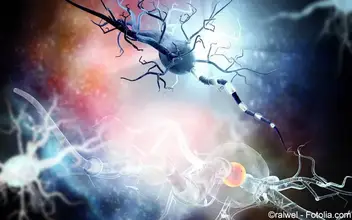Multiple Sklerose und das Altern
In den letzten Jahren konnten Zusammenhänge zwischen dem Altern und Krankheitsmerkmalen von Multipler Sklerose aufgedeckt werden. Zu verstehen, wie das Altern die Pathophysiologie und das Therapieansprechen der Multiplen Sklerose beeinflusst, könnte entscheidend das Outcome der Patienten verbessern.

Liebe Leserin, lieber Leser,
der Inhalt dieses Artikels ist nur für medizinische Fachkreise zugelassen. Wenn Sie zu diesen Fachkreisen gehören, melden Sie sich bitte auf unserer Seite an. Sie werden dann automatisch auf die gewünschte Seite weitergeleitet.
Quelle:
- Graves et al. (2023): Ageing and multiple sclerosis. Lancet Neurol. DOI: 10.1016/S1474-4422(22)00184-3
- Stankoff et al (2007): Age at onset determines the occurence of the progressive phase of multiple sclerosis. Neurology. DOI: 10.1212/01.wnl.0000256732.36565.4a
- Frischer et al. (2015): Clinical and pathological insights into the dynamic nature of the white matter multiple sclerosis plaque. Annals of Neurology. DOI: 10.1002/ana.24497
- Marrie et al. (2015): A systematic review of the incidence and prevalence of comorbidity in multiple sclerosis: overview. Multiple Sclerosis Journal. DOI: 10.1177/1352458514564491
- Mowry et al. (2018):Body mass index, but not vitamin D status, is associated with brain volume change in MS. Neurology. DOI: 10.1212/WNL.0000000000006644
- Salter et al. (2020):. Comorbidity is associated with disease activity in MS: findings from the CombiRx trial. Neurology. DOI: 10.1212/WNL.0000000000010024
- Habib et al. (2020): Association between shorter leukocyte telomeres and multiple sclerosis. Journal of Neuroimmunology. DOI: 10.1016/j.jneuroim.2020.577187
- Krysko et al. (2019): Telomere length is associated with disability progression in multiple sclerosis. Ann Neurol. DOI: 10.1002/ana.25592
- Maggi et al. (2021): Chronic white matter inflammation and serum neurofilament levels in multiple sclerosis. Neurology. DOI: 10.1212/WNL.0000000000012326
- Chitnis (2018): The role of testosterone in MS risk and course. Multiple Sclerosis Journal. DOI: 10.1177/1352458517737395
- Graves et al. (2018): Ovarian aging is associated with gray matter volume and disability in women with MS. Neurology. DOI: 10.1212/WNL.0000000000004843
- Callender et al. (2018): Human CD8+ EMRA T cells display a senescence-associated secretory phenotype regulated by p38 MAPK. Aging Cell . DOI: 10.1111/acel.12675
- Huber et al. (2018): An emerging role for eotaxins in neurodegenerative disease. Clinincal Immunology. DOI: 10.1016/j.clim.2016.09.010
- Parajuli et al. (2015): CCL11 enhances excitotoxic neuronal death by producing reactive oxygen species in microglia. Glia. DOI: 10.1002/glia.22892
- Rothhammer et al. (2018): Microglial control of astrocytes in response to microbial metabolites. Nature. DOI: 10.1038/s41586-018-0119-x
- Salazar et al. (2019): Age-associated changes in gut microbiota and dietary components related with the immune system in adulthood and old age: a cross-sectional study. Nutrients. DOI: 10.3390/nu11081765
- Franklin, Frisen , Lyons (2021): Revisiting remyelination: towards a consensus on the regeneration of CNS myelin. Seminars in Cell Developmental Biology. DOI: 10.1016/j.semcdb.2020.09.009
- Sim et al. (2002): The age-related decrease in CNS remyelination efficiency is attributable to an impairment of both oligodendrocyte progenitor recruitment and differentiation. Journal of Neuroscience. DOI: 10.1523/JNEUROSCI.22-07-02451.2002
- Neumann et al. (2019): Metformin restores CNS remyelination capacity by rejuvenating aged stem cells. Cell Stem Cell. DOI: 10.1016/j.stem.2019.08.015
- Giorgi et al. (2018): Mitochondria and reactive oxygen species in aging and age-related diseases. International Review of Cell and Molecular Biology. DOI: 10.1016/bs.ircmb.2018.05.006
- Barcelos, Troxell, Graves. (2019): Mitochondrial dysfunction and multiple sclerosis. Biology. DO:I 10.3390/biology8020037
- Montalban et al. (2017): Ocrelizumab versus placebo in primary progressive multiple sclerosis. The New England Journal of Medicine. DOI: 10.1056/NEJMoa1606468
- Kappos et al. (2018): Siponimod versus placebo in secondary progressive multiple sclerosis (EXPAND): a double-blind, randomised, phase 3 study. The Lancet. DOI: 10.1016/S0140-6736(18)30475-6
- Chataway et al. (2014): Effect of high-dose simvastatin on brain atrophy and disability in secondary progressive multiple sclerosis (MS-STAT): a randomised, placebo-controlled, phase 2 trial. The Lancet. DOI: 10.1016/S0140-6736(13)62242-4
- Fox et al. (2018): Phase 2 trial of ibudilast in progressive multiple sclerosis. The New England Journal of Medicine.. DOI: 10.1056/NEJMoa1803583
Anzeige










